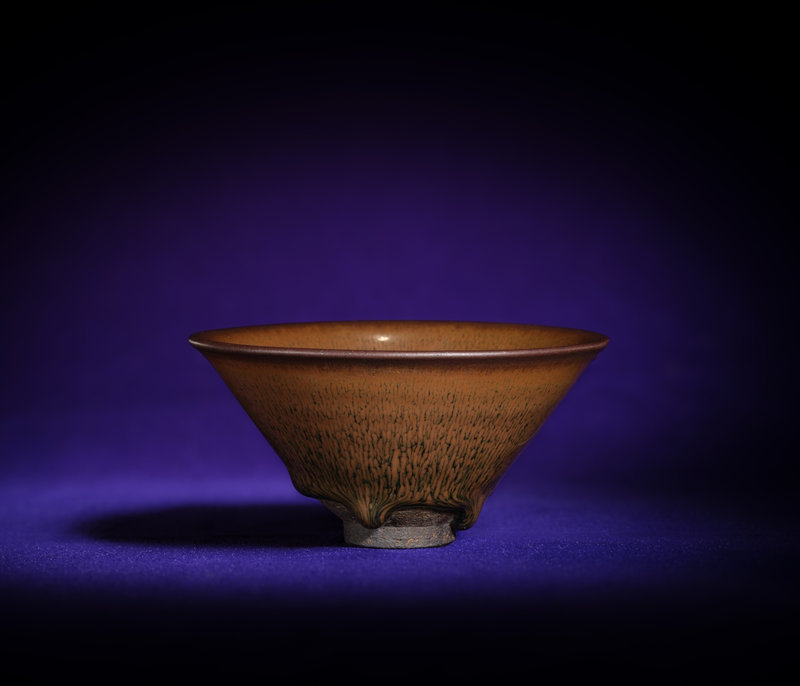An heirloom Jian russet-streaked 'nogime tenmoku' bowl, Southern Song dynasty
Lot 2521. Property of a Gentleman. An heirloom Jian russet-streaked 'nogime tenmoku' bowl, Southern Song dynasty (1127-1279); 11.5 cm, Japanese double wood box, with one of the boxes and a furoshiki wrapping cloth inscribed with Hekiundai (碧雲台, the residence of Baron Masuda Takashi). Lot Sold 2,540,000 HKD (Estimate 2,000,000 - 3,000,000 HKD). © Sotheby's 2023
Collection of Rolf Cunliffe (1899-1963), 2nd Baron Cunliffe of Headley (no. T6).
Bonhams London, 11th November 2002, lot 40.
The Le Cong Tang Collection.
Sotheby's Hong Kong, 2nd October 2017, lot 12.
Note: The unprecedented enthusiasm for tea drinking in the Song dynasty (960-1279) brought about a tea culture that contributed to the development of various new ceramic tea wares. White and celadon-glazed tea bowls were replaced in popularity by black-glazed wares, whose dark surfaces provided a more dramatic backdrop for the white froth of the whipped tea. In Chalu [Record of Tea], written between 1049 and 1053, the leading calligrapher and tea connoisseur Cai Xiang (1012-1067) notes in the section devoted to ‘Tea Bowls’ (chazhan) that if “the tea is of a pale colour, a black bowl is the best match. Bowls fired in the Jian kilns have a bluish black colour with stringy décor like hare’s fur (tuhao). The somewhat thicker bowl preserves the heat and cools slowly after having been warmed. These bowls are therefore very much in demand” (Soon-Chim Jung, ‘The Significance and Influence of the Tea Culture of the Song Dynasty’, The Monochrome Principle. Lacquerware and Ceramics of the Song and Qing Dynasties, Munster, 2008, p. 117). The Huizong Emperor (r. 1100-1126), one of China’s greatest imperial art lovers, agreed with Cai’s views and in his treatise on tea, Daguan chalun [Discourse on tea in the Daguan reign period] written in 1107, noted that the best black bowls have the hare’s fur pattern (ibid.).
The Japanese word temmoku (or tenmoku) designates the Chinese Tianmu mountains in Lin’an county, north Zhejiang province, where Jian hare’s fur (Japanese nogime) bowls, made in the neighbouring province of Fujian, were in use for tea drinking by the monastic communities who lived there. Consumption of tea was an established practice in Buddhist monasteries, as tea was prized as a stimulant in assisting monks in their meditation, as well as being ritually offered to the Buddha. When Japanese monks brought the black Jian tea bowls to Japan together with the cult of tea, they were adopted with enthusiasm.
The present bowl is notable for its glossy glaze and the evenness of the russet-coloured hare’s fur pattern, which untypically covers most of the bowl. It is further remarkable for its steep conical shape resting on a very narrow foot, which makes this bowl more elegant than the typical, more rustic tea bowls from the Jian kilns with more rounded sides and a wider foot, or of conical shape but much larger. Bowls of this form are rare, as can be seen when comparing the many line drawings of tenmoku bowls published in Tōbutsu tenmoku [Import commodity ‘tenmoku’], Chadō Shiryōkan, Kyoto, 1994, passim, where a bowl of related proportions, but somewhat larger and with the glaze retaining more black, preserved in the Tokugawa family and now in the Tokugawa Art Museum, Nagoya, is illustrated, pl. 11. A bowl with russet hare’s fur streaks similarly predominating, but of the more classic Jian tea bowl form, in the Capital Museum, Beijing, is published in Zhongguo taoci quanji [Complete series on Chinese ceramics], Shanghai, 1999-2000, vol. 8, pl. 206.
Lord Cunliffe was one of England’s most important collectors of Chinese works of art, who started in the early 1940s to collect Qing dynasty jades, soon followed by ceramics, archaic bronzes and early jades. His collection included many famous treasures, including no less than three blue-and-white Chenghua ‘palace bowls’. A large part of his collection was sold in our London rooms, and the present bowl at Bonhams London.
Sotheby's. Karamono: Heirlooms of Chinese Art from Medieval Japan, Hong Kong, 9 October 2023

/https%3A%2F%2Fprofilepics.canalblog.com%2Fprofilepics%2F1%2F0%2F100183.jpg)
/https%3A%2F%2Fstorage.canalblog.com%2F03%2F02%2F119589%2F96711876_o.jpg)
/https%3A%2F%2Fstorage.canalblog.com%2F11%2F31%2F119589%2F94773502_o.jpg)
/https%3A%2F%2Fstorage.canalblog.com%2F20%2F83%2F119589%2F94772815_o.jpg)
/https%3A%2F%2Fstorage.canalblog.com%2F26%2F72%2F119589%2F75604929_o.jpg)
/https%3A%2F%2Fstorage.canalblog.com%2F59%2F60%2F119589%2F26458628_o.jpg)







/image%2F1371349%2F20240416%2Fob_3b1c51_telechargement.jpg)
/image%2F1371349%2F20240412%2Fob_e3109f_2024-nyr-22642-0929-000-a-carved-qingb.jpg)
/image%2F1371349%2F20240410%2Fob_77912a_2024-nyr-22642-0912-000-a-superb-and-v.jpg)
/image%2F1371349%2F20240410%2Fob_7020dd_2024-nyr-22642-0909-000-a-jian-hares-f.jpg)